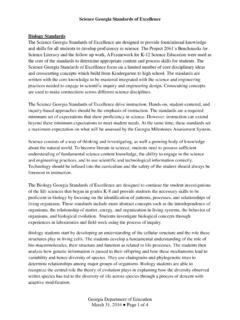Transcription of What is Science? | 5E Lesson Plan for Grades K-2 [PDF]
1 SUMMARYS tudents learn how to conduct an experiment to determine the fastest way to dissolve Kool-Aid in water. Duration: 45 minutes. CORRELATION2-PS1-2. Analyze data obtained from testing different materials to determine which materials have the properties that are best suited for an intended purpose. 2019 1 Lesson PLANWHAT IS SCIENCE? Grades K-2 Science & Engineering PracticesConnections to Classroom ActivityPlanning and Carrying Out Investigations Planning and carrying out investigations to answer questions or test solutions to problems in K 2 builds on prior experiences and progresses to simple investigations, based on fair tests, which provide data to support explanations or design and conduct an investigation collaboratively to produce data to serve as the basis for evidence to answer a question.
2 (2-PS1-1) Analyzing and Interpreting Data Analyzing data in K 2 builds on prior experiences and progresses to collecting, recording and sharing observations. Analyze data from tests of an object or tool to determine if it works as intended. (2-PS1-2) Students will conduct an investigation to see how temperature and amount of water affect the rate that Kool-Aid powder dissolves in water. Students will collect data by timing how long it takes to dissolve Kool-Aid in different amounts of water and also in different temperatures of water. Link to Video Kool-Aid powder (Any sugary drink mix with color will do) Plastic cup Plastic spoon Measuring cup Water (cold and warm) Timer (Students could also count instead of using a timer) Glass of your favorite drinkDIY Activity Small box of raisins Bottle of clear soda Cup of water 2 Tall glasses or plastic cups MATERIALS2 2019 EXPLORETell students that today they will be trying to find out how to dissolve Kool-Aid powder in water the fastest.
3 Ask students for ideas on what might make the Kool-Aid dissolve fast. After having students share ideas, tell them that they will be testing how the temperature of the water and the amount of water affects how fast it will dissolve. In order to conduct a fair test, they can only change one thing at a time. This means they will do two experiments. Experiment One: Temperature of Water 2 Cups, each with 1 tsp of Kool-Aid Cup of warm water Cup of cold water Experiment Two: Amount of Water 2 Cups, each with 1 tsp of Kool-Aid Cup of cold water Cup of cold water Point out that in each experiment they are only changing one thing and keeping everything else the same. This is the most critical part of the Lesson . Crosscutting ConceptsConnections to Classroom ActivityCause and EffectSimple tests can be designed to gather evidence to support or refute student ideas about causes.
4 (2-PS1-2) Students will discover that an increased temperature will affect the rate that Kool-Aid dissolves in water. They will also learn that more water also helps the Kool-Aid dissolve more quickly. ENGAGEB egin the Lesson by taking a big drink of your favorite beverage and exaggeratedly say, Ahhhh, so refreshing! Ask students if they have a favorite beverage that they like to drink on a hot day. Allow students to share out loud, and hopefully someone will say Kool-Aid or lemonade. Follow up by asking, Have you ever made Kool-Aid or lemonade from a powder? This will lead into the exploration of the Core IdeasConnections to Classroom ActivityDifferent properties are suited to different purposes.
5 (2- PS1-2),(2-PS1-3) Students will investigate how temperature and amount of water affect the rate that Kool-Aid dissolves in water. EVALUATES tudents can turn in their science notebooks or papers. Students can also play the online Kahoot! quiz game located below the video which provides downloadable scores at the end of the quiz game. Alternatively, you can use the paper quiz or the exit ticket questions. All these resources are located below the video in the Assessment section. ELABORATED iscuss that the students just conducted an experiment in the same way that real scientists conduct experiments. Scientists are careful to only change one thing at a time, so that they can determine the exact thing that is causing a change.
6 Scientists make careful observations with their five senses and keep detailed notes when they conduct experiments. They can then refer to their notes as they test different things. Scientists often do the same experiment a few times so they can be sure of the results. Next Generation Science Standards is a registered trademark of Achieve, Inc. A non-profit dedicated to raising academic standards and graduation requirements. 2019 3 EXTENSIONO lder or more advanced students might be ready for some sophisticated vocabulary. For example, when writing predictions, use the word hypothesis. This activity can be expanded to test other variables such as dissolving in different liquids like apple juice. Experiments can also be repeated with the results averaged to produce more accurate data.
7 EXPLAINA llow student groups to share their findings from the experiment. They should conclude that the Kool-Aid dissolves faster in warm water. They also should conclude that the Kool-Aid dissolves faster in more water. The mechanisms for a solid dissolving in a liquid is above grade level and does not need to be THE GENERATION GENIUS WHAT IS SCIENCE VIDEO AS A GROUPF acilitate a discussion using the discussion questions before and after the video. Have students record predictions in a science notebook or on a piece of paper. Students will start the timer as they begin to stir with a plastic spoon. They will know that the Kool-Aid has dissolved because they won t feel or hear the grittiness of the granules on the bottom of the cup and it will be visible, too.
8 Once they have the time for one condition (hot vs. cold or less vs more water), they can do the next one. Be sure students stir it the same way each time (same speed and method) to keep everything the same and to only change one thing at a time. Record results in a science notebook or on a piece of paper.
![Living vs. Non-Living | 5E Lesson Plan for Grades K-2 [PDF]](/cache/preview/1/5/0/5/c/1/5/2/thumb-1505c15273daf157385e9717a453fa28.jpg)
![Weather vs. Climate | 5E Lesson Plan for Grades 3-5 [PDF]](/cache/preview/d/7/c/0/6/c/d/6/thumb-d7c06cd6fdf48a1bc04b4f1b0e7e23b6.jpg)
![Weathering & Erosion | 5E Lesson Plan for Grades 3-5 [PDF]](/cache/preview/f/0/5/2/c/e/5/b/thumb-f052ce5b2e69fc2ea580a59cb704d9d6.jpg)
![Ecosystems | 5E Lesson Plan for Grades 3-5 [PDF]](/cache/preview/3/7/3/5/6/2/e/1/thumb-373562e11bfd5c636d56d01f227d09a5.jpg)


![Natural Disasters | 5E Lesson Plan for Grades 3-5 [PDF]](/cache/preview/8/0/9/c/e/7/2/f/thumb-809ce72f931e610fe94c698182f94da5.jpg)
![Sun & Stars | 5E Lesson Plan for Grades 3-5 [PDF]](/cache/preview/3/8/9/6/7/a/2/9/thumb-38967a29ac1fe92fba7fa7d775945b90.jpg)

![Human Body Systems | 5E Lesson Plan for Grades 3-5 [PDF]](/cache/preview/5/3/7/d/5/f/0/a/thumb-537d5f0a980c7ec9133056914a11eb75.jpg)


